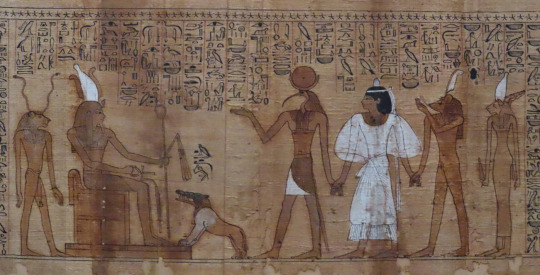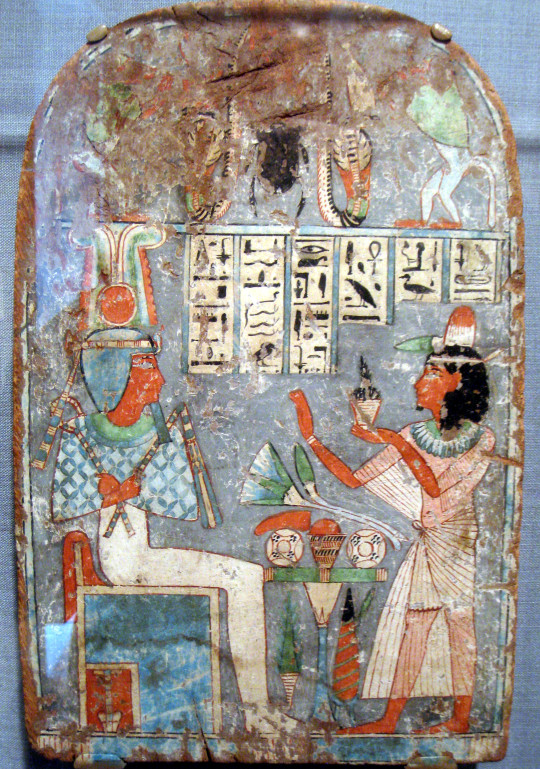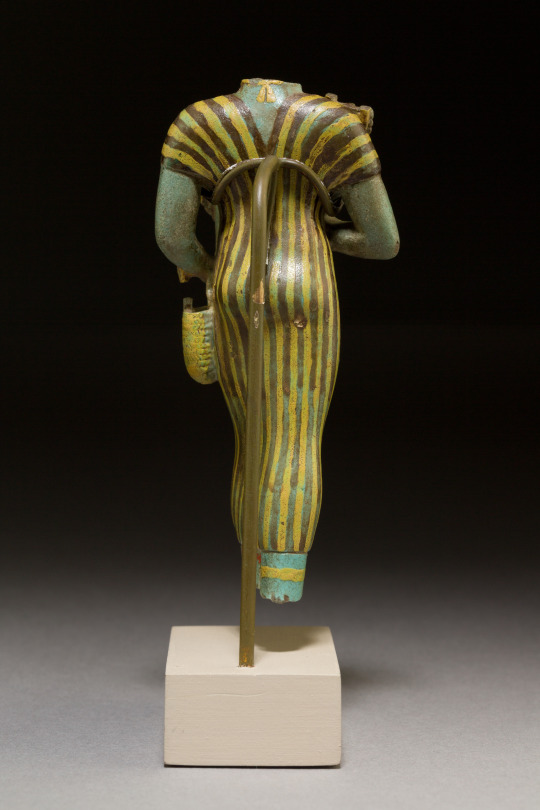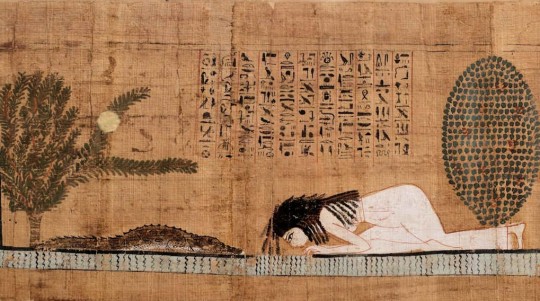#Third Intermediate Period
Text

Lotiform Chalice
Third Intermediate Period
Ca. 945–664 B.C.
From Middle Egypt, Tuna el-Gebel region; From Egypt.
The fragrant blossom of the blue lotus is a common motif in all forms of Egyptian art. Because it opened its petals to the sun each morning, the flower became a symbol of creation and rebirth. During the Third Intermediate Period, faience chalices derived from the shape of the blossom and other faience delicacies were decorated with relief scenes evoking a constellation of myths having to do with the birth of the king as child of the sun god out of the watery marsh environment, and thus the renewal of the world out of the flooded land anticipated with the beginning of the Inundation at the Egyptian New Year.
#Lotiform Chalice#Ca. 945–664 B.C.#Third Intermediate Period#blue#blue lotus#pottery#Egyptian pottery#ancient pottery#ancient artifacts#archeology#archeolgst#history#history news#ancient history#ancient culture#ancient civilizations#ancient egypt#egyptian history#egyptian art
800 notes
·
View notes
Text

Amulet of the Goddess Sekhmet
Egyptian, Third Intermediate Period (about 1069–664 BCE)
With the head of a lion and the idealized figure of a woman, this amulet depicts a powerful ancient Egyptian goddess. Ancient Egyptians—both living and dead—wore amulets of gods and goddesses to bring protection and health. These included depictions of deities in their human, animal, or mixed forms.
This amulet represents one of several goddesses who appeared in a hybrid leonine-human form, likely Sekhmet, a goddess of pestilence and divine violence. In Egyptian mythology, Sekhmet acted as the Eye of Re, the daughter and protector of the sun god, Re. She had the ability to make enemies fall sick or heal those who were afflicted, so she would have provided the wearer of this amulet with protection from disease and other dangerous forces.
353 notes
·
View notes
Text

The papyrus of Tjanefer. Thoth and the mouse-headed god, who wears a single maat-feather, hold the deceased's hands as the lead him to Osiris. They're followed by Hepet-Hor, who has lioness- and crocodile-faces, wears a white crown, and holds a pair of knives. The Devourer stands with her front paws on the base of Osiris' throne like a pet who wants a treat; I think this is a way of quickly summarising the judgement scene. Behind Osiris is a lion-headed god with two wriggly snakes coming out of his head. (Anyone who can read the hieroglyphs over the Devourer's head will have my eternal gratitude.)
When: Third Intermediate Period, 21st Dynasty
Where: Egyptian Museum, Cairo
#Ancient Egypt#papyrus#Amduat#Hepet Hor#Osiris#Thoth#mouse god#The Devourer#Third Intermediate Period#21st Dynasty#Egyptian Museum Cairo#Tjanefer
87 notes
·
View notes
Text

Ancient Egyptian stele (painted wood) showing a certain Ankh-auf-Mut adoring the seated deity Osiris. Artist unknown; Third Intermediate Period. Now in the Worcester Art Museum, Worcester, MA.
#art#art history#ancient art#Egypt#Ancient Egypt#Egyptian art#Ancient Egyptian art#Third Intermediate Period#stele#stela#Egyptian religion#Ancient Egyptian religion#kemetic#Osiris#Worcester Art Museum
362 notes
·
View notes
Text

~ Statuette of Anubis facing a kneeling worshiper.
Period: Third Intermediate Period to Late Period, 25th-26th dynasty
Date: ca. 747-525 B.C.
• Translation from the source: May Anubis, give life, health, long life and great and good old age to Wdja-Hor-resnet, son of Ankh-pa-khered, whose mother is Ta-gemiw(t), who is born (made) of the Mistress of the house, Hy-inty for Pen-pa-djew. May Anubis give life to Wdje-hor-resnet, son of Ankh-pa-khered. May Anubis, who is before the place of the divine booth, give life, health, strength, a long life, and a great old age and happiness to the son of Ankh-pa-khered, whose mother is Ta-gemiw(t), who is Mistress of the House, Hy-inty for Pen-pa-djew.
#ancient#ancient art#history#museum#archeology#ancient egypt#ancient sculpture#archaeology#ancient history#egyptian#egyptology#egypt#anubis#worshipper#third intermediate period#25th Dynasty#26th dynasty#ca. 747 b.c.#ca. 525 b.c.
942 notes
·
View notes
Text

Inner Panel from the Coffin of Djedmut from Egypt dated between 945 - 900 BCE on display at the Burrell Collection in Glasgow, Scotland
This image was painted on the inside of the coffin. It was not meant to be seen by any living person after Djedmut had been buried in her tomb.
Photographs taken by myself 2023
#art#archaeology#history#ancient#egypt#egyptian#bonze age#third intermediate period#burrell collection#museum#glasgow#barbucomedie
6 notes
·
View notes
Photo

Plaque of Iuput II
Faience plaque with a low-relief depiction of Iuput II as an infant king wearing the triple Atef crown, and emerging from a lotus flower as the sun god. Lower Egypt, probably Leontopolis, Ancient Egyptian, 23rd Dynasty, c.750-716 BCE
5 notes
·
View notes
Text







Bastet with Nefertum figure, sistrum, and basket - Met Museum Collection
Inventory Number: 17.194.2214
Third Intermediate Period–Late Period, 945–600 BC
Location Information: Location Unlisted
Description:
Although the head, made separately, is now missing, this goddess is identifiable as Bastet. The striped robe is characteristic of the goddess, as are the sistrum and basket she holds. The small statuette with a lotus crown represents her son Nefertum.
#Bastet with Nefertum figure sistrum and basket#bastet#third intermediate#late period#met museum#17.194.2214#location unlisted#womens clothing#TIWC#LPWC#deities#deitiesw
4 notes
·
View notes
Text
If we accept the ~1100 BC dating as correct for Atem (which I do) then he coincides with the decline of ancient Egypt as a powerful state. in other words it's historically accurate for pharaoh set to put his foot through it
#something poetic about denying justice to kul elna and the subsequent collapse of the ancient egyptian state into#factional politics and civil wars and invasions in the third intermediate period#intern memo
36 notes
·
View notes
Text

Ring with Cat and Kittens
Ramesside/Third Intermediate Period
ca. 1295–664 B.C.
1K notes
·
View notes
Text

Herwebenkhet, Chantress of Amun, prostrates herself before the god Geb in the form of a crocodile and drinks from the waters that will unite her with the gods and assure safe passage to the afterlife.
The strongly built shape of the body of the deceased exemplifies a new image for the female figure in this period. It contrasts with the slender images that were in vogue earlier.
Third Intermediate Period, 21st Dynasty, c. 1069-945 BC. Now in the Egyptian Museum, Cairo. SR 19325
Read more
1K notes
·
View notes
Text

An Egyptian Bright Blue Glazed Faience Shabti
Third Intermediate Period, 21st-22nd Dynasty, circa 1069-735 B.C.
#An Egyptian Bright Blue Glazed Faience Shabti#Third Intermediate Period#21st-22nd Dynasty#circa 1069-735 B.C.#statue#sculpture#ancient artifacts#archeology#archeolgst#history#history news#ancient history#ancient culture#ancient civilizations#ancient egypt#egyptian history#egyptian mythology#egyptian gods#egyptian art
61 notes
·
View notes
Text

Lionness Headed Usekh, So Called "Aegis"
Egyptian, 1290-664 BCE (Late New Kingdom-Third Intermediate Period)
Silver was not easily obtainable in Egypt and was probably more costly for ancient Egyptians to acquire than gold.
#artifact#Egypt#new kingdom#third intermediate period#Aegis#lioness headed Usekh#pendant#embossed silver
150 notes
·
View notes
Photo

A row of gods inside the 21st Dynasty coffin of Amenemipet at the British Museum. The snake-headed, bearded god looks like “The Gentleman”, the figure from coffins and papyri that I’ve been trying to identify.
[The five gods are mummiform with white bodies and red mummy braces. Each wears a sash of green and orange. Three have human faces; one has a cat’s head, and one a snake’s head with a beard. Above them is a row of hieroglyphs, and above that, a frieze of tyet knots and djed pillars.]
#Ancient Egypt#British Museum#21st Dynasty#Third Intermediate Period#coffin#cat god#The Gentleman#Amenemipet
331 notes
·
View notes
Text

Ancient Egyptian faience amulet in the shape of a winged scarab. Artist unknown; ca. 1070-945 BCE (21st Dynasty, Third Intermediate Period). Now in the Metropolitan Museum of Art.
#art#art history#ancient art#Egypt#Ancient Egypt#Egyptian art#Ancient Egyptian art#Egyptian religion#Ancient Egyptian religion#kemetic#jewelry#jewellery#amulet#faience#scarab#21st Dynasty#Third Intermediate Period#Metropolitan Museum of Art
502 notes
·
View notes
Text

Funerary Stela from Luxor, Egypt dated between 650 - 640 BCE on display at the National Museum of Denmark in Copenhagen, Denmark
Baba, daughter of the priest of Amu Bes-n-Mut, praying to the sun gods Amun (left) and Re-Hrakhte.
Photographs taken by myself 2018
#art#archaeology#history#egypt#egyptian#ancient#bronze age#third intermediate period#national museum of denmark#copenhagen
6 notes
·
View notes